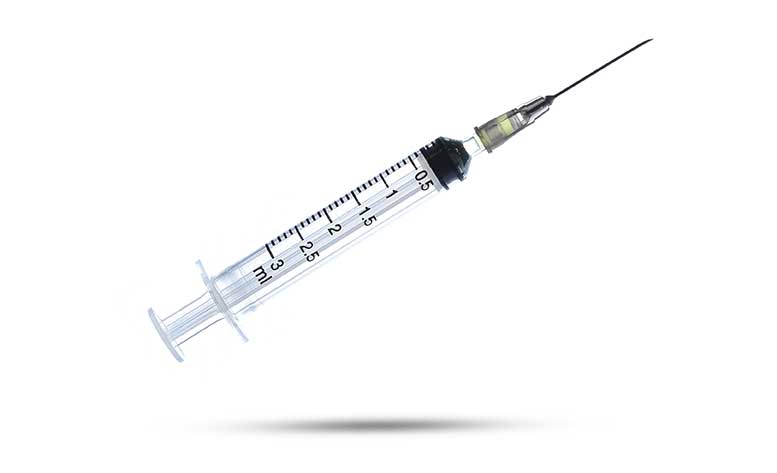Injecting Hydrocodone | Intravenous Hydrocodone Use

Medically Reviewed By: Manish Mishra, MBBS

The semi-synthetic prescription drug hydrocodone is widely used in health care to treat moderate and severe pain. It can be found in well-known brand-name medications like Vicodin, which also contains the over-the-counter pain reliever acetaminophen.
Unfortunately, hydrocodone pain relief medications are prone to abuse. And despite increasing efforts to create tamper-resistant pain management formulations, hydrocodone tablets are still sometimes modified and injected to increase the drug’s euphoric effects.
Effects Of Injecting Hydrocodone Medications
Unlike the illicit drug heroin, hydrocodone tablets must first be ground into a fine powder before they can be mixed with water, loaded into a syringe, and injected.
This rapidly delivers both hydrocodone and filler materials into the bloodstream. The drug then interacts with opioid receptors in the central nervous system and releases a surge of dopamine and intense pleasure often referred to as a “rush” or “flash.”
Other immediate side-effects of injection opioid use may include:
- constipation
- drowsiness
- lightheadedness
- fuzzy thinking
- mood changes
- difficulty urinating
- itching or rash
- chest tightness
- sexual or reproductive dysfunction
Dangers Of Injecting Hydrocodone Medications
Injecting opioid drugs is a particularly high-risk method of drug abuse that can expose a person to severe short-term and long-term risks.
These risks are shared among all prescription opioid/opiate painkillers, including oxycodone (OxyContin), hydromorphone, codeine, and others.
Skin Infections & Scarring
Because injection drug use rarely occurs in sterile environments, it is strongly associated with skin infections leading to abscesses, open wounds, scabs, and other infections.
This, in combination with the damage caused by syringe needles, themselves, can lead to severe and often permanent skin scarring and disfigurement around injection sites.
HIV
HIV (human immunodeficiency virus) is a disease that targets the human immune system and spreads through the transfer of bodily fluids.
If you use a non-sterile needle or syringe that has also been used by someone with HIV, you face a high risk of contracting the virus yourself. And the virus can also be passed through unprotected sexual contact, which is more likely to occur among those with substance use disorder.
Hepatitis C
Hepatitis C is another viral infection that can be transferred through shared needles, leading to severe liver problems that can be very difficult to detect until the damage becomes severe and potentially life-threatening.
Endocarditis
Endocarditis is an infection of the endocardium, the interior lining of the heart, which can occur when bacteria introduced by a needle enters the bloodstream. Without advanced medical treatment, endocarditis can also be fatal.
Opioid Overdose
Because injection drug use can deliver such a large dose of hydrocodone into the bloodstream so quickly, it can also greatly increase a person’s risk of experiencing dangerous overdose symptoms, including respiratory depression (breathing problems).
Signs and symptoms of a hydrocodone overdose can include:
- gasping, slow breathing, or shallow breathing
- slow, weak heart rate
- reduced blood pressure
- pinpoint pupils
- severe drowsiness
- cold, clammy skin
- blue colored lips or fingertips
- loss of consciousness (coma)
Hydrocodone overdose can be fatal, especially in combination with other strong central nervous system depressants (alcohol, benzodiazepines, sleeping pills) or stimulants (methamphetamine, cocaine, amphetamines).
Overdoses have also occurred when illicit fentanyl, a hyper-potent opioid analgesic, has been used to counterfeit hydrocodone pills.
If you suspect an opioid overdose has occurred, you should administer naloxone and summon emergency medical responders.
Hydrocodone Addiction
Abuse of hydrocodone in any form increases the risk that a person will develop physical dependence or addiction to the drug. And this risk increases even more if the medication is tampered with and abused through injection or snorting.
Signs of hydrocodone addiction may include:
- developing increased tolerance to hydrocodone’s effects at your regular dosage
- experiencing unpleasant withdrawal symptoms when you stop taking hydrocodone
- seeking more of the medication through doctor-shopping or illicit purchases
- withdrawing from your loved ones
- falling behind in your responsibilities at work or school
- losing interest in important things in your life
Hydrocodone Addiction Treatment
Participating in a professional, personalized treatment program for hydrocodone addiction can give you the help you need to make a lasting, positive change in your life.
Common treatment options, available in both inpatient and outpatient settings, include:
Medical Detoxification
Medical detox programs can help you work through withdrawal symptoms with close medical supervision and support, helping you break the pattern of substance abuse.
Medication-Assisted Treatment (MAT)
MAT programs have improved many people’s recovery journeys using FDA-approved medications like buprenorphine and methadone, which can stop cravings and withdrawal symptoms, or naltrexone, which can discourage future opioid use.
Dual Diagnosis Treatment
Dual diagnosis treatment can help manage other co-occurring conditions that may be contributing to a pattern of injection drug abuse. These can range from chronic pain to mental health disorders.
If you would like to hear more about treatment options for prescription opioid abuse and addiction, please contact Ohio Recovery Center today.
- Food and Drug Administration (FDA) — Abuse-Deterrent Opioid Analgesics https://www.fda.gov/drugs/postmarket-drug-safety-information-patients-and-providers/abuse-deterrent-opioid-analgesics
- National Institute on Drug Abuse (NIDA) — Prescription Opioids DrugFacts https://nida.nih.gov/publications/drugfacts/prescription-opioids
- National Library of Medicine: MedlinePlus — Hydrocodone https://medlineplus.gov/druginfo/meds/a614045.html
- Substance Abuse and Mental Health Services Administration (SAMHSA) — MAT Medications, Counseling, and Related Conditions https://www.samhsa.gov/medication-assisted-treatment/medications-counseling-related-conditions
- UCLA: Semel Institute for Neuroscience and Human Behavior — Potential Complications Of IV Drug Use http://www.semel.ucla.edu/dual-diagnosis-program/News_and_Resources/Potential_Complications_Of_IV_Drug_Use

